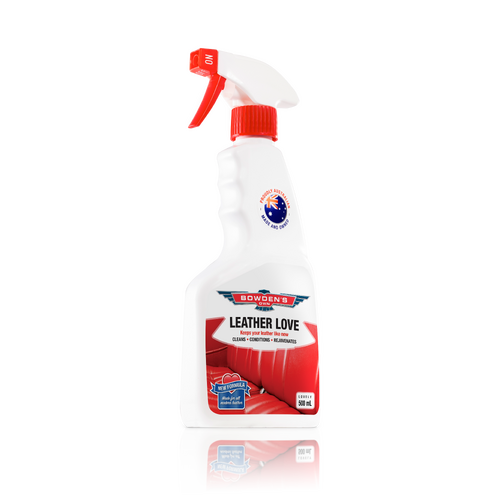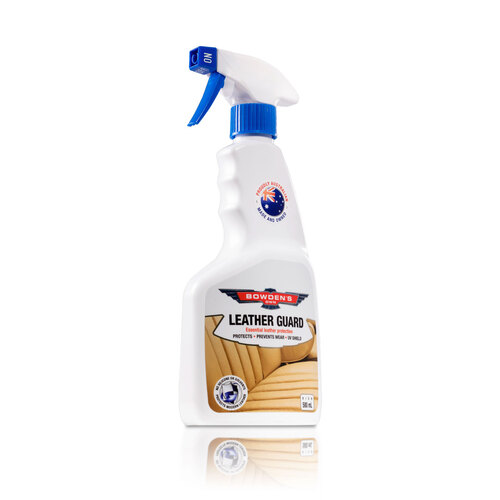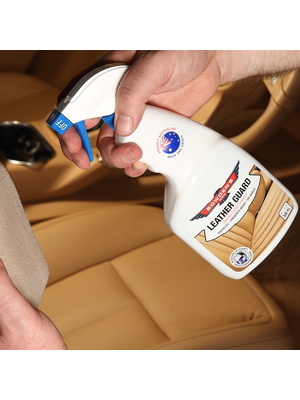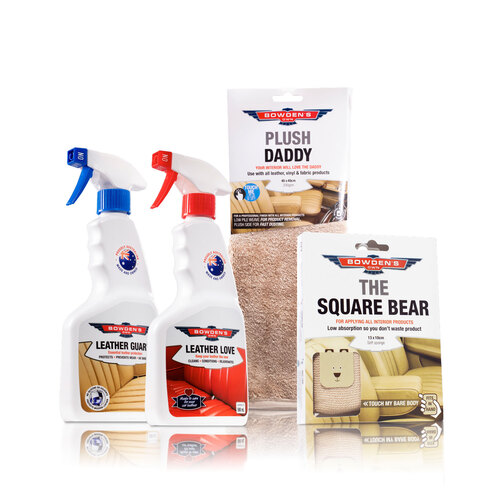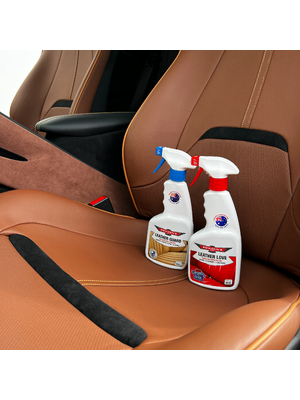Real leather care for all modern cars
Correct Leather care is critical for all modern car leather. Take the time to have a read into our long journey to create products to properly care for them.
Leather care advice from our Chemists
A couple of years ago we sat down with some specialised industrial chemists who have worked in the leather manufacture and care industry for over 35+ years. They were a lot smarter than us (not that hard really) in understanding what the ideal product is for maintaining the leather surfaces in cars. When researching what was being used currently, we sadly found a variety of products that simply were not suitable for the current auto leather.
For the reason of dollars rather than sense, nearly all the array of products contained oils, silicones, paraffins, waxes, petroleum distillates, or a lethal concoction of these. All of which ARE NOT SUITABLE FOR POLYURETHANE (PU) COATED LEATHER, as used in nearly every-car since the mid 1980's. If used on a regular basis they can damage the PU top coat of the leather. Most actually do the opposite of what they claim, by damaging the coating, and making it vulnerable to accelerated wear and even de-laminating. So it initially feels nice and soft on the outside, but it is being killed by the products permeating into the coating and disrupting the structure. So, let's explain the dramas you can face with these 'leather care' products.

What's my leather type?
You can tell what type of leather your car has with this easy test; put a small drop of clean water on the surface of the leather seat, let it sit for 30 seconds and then wipe it off. If it gets absorbed into the seat and leaves a mark, it is certainly an uncovered type (don't worry, the drop mark will evaporate and not damage the seat), if water does not penetrate and beads on the surface, and leaves no darker mark, you've got the pigmented PU coated leather or a semi aniline coated leather.
Another test is scratching the leather with your finger nail, if it changes colour to a darker or lighter shade it is not protected and would be an Aniline type. Some super expensive exotics and luxury transports still occasionally use this leather, but due to its hard to care for nature it has been slowly phased out of the cockpit. With nothing on the surface protecting them, the use of special cleansers, protectants, oils, balms and even some waxes can be used to clean and maintain them.
However, for the vast majority of vehicles, in this day and age of better designed leather, this is not the case. Neatsfoot, Lanolin, Mink Oil, Beeswax (or any natural wax), Tea Tree Oil, oil based conditioners, even the falsely named Banana Oil (we always have a laugh at this one, as it is impossible to get any oil from a banana, no matter how hard their marketing departments have their hand working away at it. Its real name is isoamyl acetate - nothing at all that comes from an actual banana, and certainly not a suitable ingredient for leather care). All these traditional ingredients are now damaging to PU coated leather, regardless of what they say on the product label.

Oil's not well in the car
Before the 80's, most leathers used in cars were a nice top grain, reasonable quality product. They were not sealed with a protective coating and required a lot of work to look after them correctly. We have a few cars in our collection with this type of leather, but most notably a 1955 300SL Gullwing Benz and my personal favourite, the 1964 AC/Shelby competition Cobra. Both have the original trim from the factory and have a marvellous patina to them that only happens with leather that has aged well. In these vehicles is a non sealed, aniline type dyed leather, which requires old world skills and products to look after them.

Why can't I come in?
The reason why oils do not work is pretty simple chemistry; Pigmented PU coated leather is still after all its processes and protective coverings, hygroscopic, meaning it can absorb moisture. The cross-linked polymer coating is damaged by oils which cannot penetrate into the coated leather surface and bring the much needed moisture to the leather hide (even parking the car out in the sun to expand the surfaces pores with heat doesn't work). In fact, they do the opposite to what you need, sealing the surface so no moisture can get in at all. This in effect is bringing on the opposite of what you're after, leather dehydration.
They also attract dust and grime, trapping it in the surface, helping further damage the top coat. To their benefit, they can leave the leather looking nice and supple, but it's all skin deep. They cannot do the job required, and in our experience should no longer be used on any modern leather.
Slip sliding away
Silicones are the basis for many car care items and the interior is not an exception. In fact, the biggest seller of interior care uses it as the major ingredient in their interior care system. Why you ask? Think $$$$... It's bloody cheap.
Again, not ideal for leather in the same way oils aren't; they seal the surface, drying the leather out and even worse, they make it slippery, something I personally don't enjoy in any car. Silicone also helps attract dust, make it artificially shiny (losing that beautiful, natural leather sheen) and can help bring on cracks in polyurethane coated surfaces as it builds up with each coat you apply.
A lot of the ones that use this in them say they are good for all interior surfaces. Be wary of ANY product that says it can be used on both leather and vinyl, as vinyl is a different covering material and needs an entirely different product formula to effectively clean and protect it from the elements. Most cheap leather care products tend to use silicones or our next beauty of an ingredient...
Alcohol abuse
Sadly, it's no fun for leather that has been affected by alcohol consumption. Alcohol and petroleum distillates/solvents work away to erode the water based, leather PU protective surface, sometimes it can even mark permanently. It was designed for solvent based urethane topcoats used in some leathers before 1988. It accelerates leather age by removing the soft surface and may make it harder and brittle with prolonged use. Any stitching it comes in contact with can lose its colour as well.
One huge American 'car care' company uses this as an ingredient as it cleans and dries very quickly, however its cleaning power is not that smart when the leather loses its protective top coat and the cleaner then penetrates into the dye, allowing colour migration. So you frighteningly get the colour of your leather into your cleaning cloths as the top coat is gone! As you can imagine, it's all downhill from there. The only way to fix this is by a professional reapplying the dye and then the polyurethane surface back onto it, or just replacing the leather. Not a cheap exercise to fix.

Wool over your eyes
Lanolin (sourced from sheep fleece) is mentioned above as another no go ingredient. We are faced with two dramas using it; one, it again cannot penetrate the polyurethane top coat, stopping the moisture from getting to the hide, and two; the greasy, smelly film it leaves beds into the clothes of those unfortunate enough to sit in the seat after a treatment, which could be seen as a good kiwi attractant when walking through Bondi, but not really what most of us are after as a bi-product. Most greasy 'leather conditioners' will be using Lanolin.

Raw Hide
Saddle Soap? Where to start with this beauty. Some years ago, when I got my SS Holden ute, I was interested to read the leather care page in the owners manual. Saddle soap was to be used, said Holden back then. Now, after countless trims have been replaced or damaged, it's no longer in their new car manuals. Why is this? It shows how strong the myth is, that even a big manufacturer like Holden got dragged into believing in this product. I still see it recommended by many people who obviously have no idea on the evil it releases into their trim. It's formulated for an entirely different type of leather, namely those used in equestrian activities. Saddles, bridles are nothing like your cars leather for good reason; they are exposed to the elements and need more weatherproofing than any car (even convertibles) should see. It was used in the late 1800's as a leather softening conditioner, but no longer, as better, more modern emulsions have been formulated that soften, penetrate and condition a lot easier
Saddle Soap has an alkaline pH (of about pH 9 to 10). It's important that any leather product is pH neutral, as any level of alkalinity can damage the PU top coat, not to mention help shrink and crack it over time. It's supposed to be a good cleaner, but its effectiveness at even this is also on the block. Its alkaline detergents first need to dissolve its own fat and oils before it can even begin to work on the leathers' dirt and body oils. Plus, they recommend when cleaning to really lather it up, which means any dirt suspended in the lather gets pushed back into the top coats pores, helping bury it in there for a lot longer than we want it.
Finally, while it works away damaging the leathers polyurethane surface, you get more great bonuses; wax and solvents, to firstly seal the leather coating (its going to be getting a bit dry in there) and then degrade it away at the same time. This product is an urban myth in the benefits it offers automotive leather, and in our opinion it should not be used anywhere in your car.

Feed me, Feed me?
Leather is already a dead material and the processes it's tanned with ensure that the fibres in it cannot be fed, sorry. Hide foods are something again that can be used in the horse and saddle business or with the older aniline type dyed leathers. Again, they cannot get past the top polyurethane coat and has no place in modern cars with top coated PU leather.

Nanotechnology?
Over the last few years we have seen some amazing advancements with products using nanotechnology ingredients to protect many different surfaces. While we agree that they do an amazing job of repelling things like liquids, they aren't good for modern top coated leathers, as again they totally seal the surface, more so than any oil or silicones. So once again it cannot breathe and re-hydrate, leading to leather failure over time. Use them on your fabrics, or exterior surfaces, but not the leather.
What the hell can be used then?
Well, after long and drawn out discussions with our chemists, we began looking into another avenue of care. We worked out that two different products were needed, one for cleaning/ maintaining and another to offer protection from wear and tear. It took two years to perfect them, with numerous tests and reformulations, where we almost sent those poor chemists into a brain induced meltdown! But they finally created our two modern water based formulations, that work on the important principle that water molecules are smaller than the ones used in the polyurethane top coats, so they can permeate through in vapour form, deep into the leather hide. Something that is essential to restore the suppleness and maintain leathers natural flexibility. And being water based also allows the leather surface to breathe, alleviating all the drying properties oils and other sealing products can create.
Our two product system, Leather Love and Leather Guard are world class formulations that addressed the problem we faced with leather care products that are not suitable for automotive leather. We are confident enough in the way they work to put our family name on them both, all made in Australia, for our climate and conditions, making them very unique and special.

V2 update
Our Leather Love V2 update brings with it a total rework of what was already a great product. We had to make sure we used the very latest premium ingredients possible. We really had to think about all the critical aspects that make a good leather cleaner and conditioner, like cleaning ability, ease of use, hydration capability, fragrance and overall usability. It’s still water based, pH neutral, non toxic and biodegradable, and importantly, will leave a lovely matte finish and won’t make your seats slippery.
After more than 2 years of formulating and testing scores of different versions, we were finally happy with a formula. From here, we sent some of this completed version to a host of professional detailers across the country to get their feedback and then made some small tweaks for the final product.

What do they do?
They have a big range of carefully thought out benefits, which is why they took so long to develop and perfect. In summary here is what we built into them:
- Safe, but very effective cleaning properties that cannot damage the leathers PU top coat. As you can see in the half-half image below, Leather Love cleans all dirt, dust, salt, light stains and body oils off from these old and badly neglected seats with no fuss.
- pH neutral, again to save the top coat and help maintain leathers neutral pH value, so it stays like new, longer. A bonus is it won't irritate or harm sensitive skin.
- Non toxic. It's touching your skin, quite a lot, when applying and later sitting in the seats, so this was a big one for us.
- Biodegradable. We don't like things that can damage the environment, especially our great countries land or ocean.
- Non greasy or slippery so it doesn't attract dust. It can be used on steering wheels and won't let you slide in the seats.
- Neutralises harmful bacteria and microbes. These create mildew and mould which distress the top coat and hide fibres and damage the leather if not treated.
- UV protectants to help slow up UV-B rays hurting the top coat and further minimising colour loss.
- Restores the new natural sheen. We buy leather for the beautiful, natural look it gives. Any shine just makes it look cheap and artificial. A nice, clean, natural sheen is what we needed.
- That lovely, new leather smell. And not over-powering in a way that you or your passengers feel like you're in a leather tannery.
- There are no solvents, alcohol, oils or silicones, for reasons all stated quite strongly above.
- Does not build up on the surface with extra applications; it's a diminishing, sacrificial product. This way any new coats work directly to protect and care for the surface of the leather.
- No white residue left in perforated seats, words cannot express how much we hated this, so we simply engineered it out.
- Non hazing. We disliked the haze interior products give on the inside of windows, so asked for something that would give minimal residue, so not to end up caking windows after every time we used it, should have seen their faces when we asked for that one? Or ours when they did it a full year later!
- The Leather Guard is a pure protectant for abrasion resistance, for preventing wear and tear as you slide over the seat bolsters, seams and stitching, also helping stop any liquids from affecting or staining the coated surface. But still allowing it to breathe and rehydrate, so it keeps feeing like new.
- Re-hydration is the most important thing in both products formulas, so needed moisture can now get back in and nurture the hide, with other key ingredients so it keeps your leather feeling soft and supple, keeping it like new.

How often should I use it?
Leather Love should be used to clean and rehydrate/condition your seats at least every 1 to 2 months, using it more often in the hotter, summer months. While the Leather Guard should be re-applied on every 2nd or 3rd application of the Leather Love. This is due to the wonders of modern chemistry, as the Leather Love does not want to remove the protective qualities of the Leather Guard. It is however, a sacrificial product and the protectant slowly dissipates over time, so doing it at least a couple of times every year will maintain the protection the leather surface needs.
And don't worry, you can never overdo it with either of the two products, use as often as you feel you need it.
Using this system will give your leather the best possible chance to survive our harsh climate, as well as keeping it looking and feeling like new for many years to come.

Feeling Hard?
If your seats are feeling a bit harder than you would hope, or they are very neglected, we recommend doing the above cleaning process with the Leather Love twice, even three times. This in effect will give deep re-hydration to the leather hide and bring back the suppleness. Use as per above for the first initial clean, then for the 2nd clean, don't wipe the Leather Love from the surface, instead, leave it there for 3 to 4 hours or overnight. No need to wipe it off when you get back to it either, just apply a third coat, leave sit for a minute and then wipe it down. You should note the leather feels a lot more supple after this process. Finish up by applying the Leather Guard.

EASY TO USE
For quick cleaning and conditioning
It's all pretty simple, and thankfully easy to use.
Step 1
Firstly, get rid of any grit or bigger particles by cleaning the seats down with a vacuum cleaner, (soft brush extractor on the end is best). Make sure the car is in a cool area and the leather is not warm to touch, as heat tends to evaporate the products good stuff before it can get into the leather hide.
Step 2
We have two ways to clean the leather depending on how dirty it is. Spray the Leather Love into one of our Square Bear microfibre applicator pads. It's made for this type of product application, long loops in its weave give effective cleaning on the leathers undulating surface. If your leather is quite dirty, we also recommend using the first application of Leather Love with a brush that uses super soft horse hair, to really help release the built up dirt and grime. Our Plush Brush and Pouncer detailing brushes are perfect for this.
Step 3
Gently massage away into the leather, using a gentle circular motion. Cover the entire surface and let the product do the work; you don't need to rub hard or apply extreme pressure. Pay extra attention to high wearing points, as well as areas that your skin or sweat can come into contact with; seat backs, side bolsters and your steering wheel.
Step 4
While the Leather Love is still wet, wipe off with a folded, low pile side of our Plush Daddy interior microfibre cloth. This wet residue will contain all the dirt and grime that was built up on the surface, so fold it to a clean side often, so you don't wipe the same dirt back into the leather.
Apply the Leather Love a 2nd time as per above with the Square Bear (not a brush), but this time leave it sit for a couple of minutes before buffing off any remaining residue (ONLY DO THIS SECOND TIME IF THE LEATHER IS OLD AND DRY).
The image of the Square Bear pad on the seat shows the left half of the seat cleaned - a noticeable difference to the right side. Leather Love has some great cleansers in it, making it an easy job to remove the built up grime, fast and no fuss!
When the Square Bear pad is starting to look a bit dirty, it will pay to hand wash it in a bucket of water, rather than continually rubbing the built up dirt back into the rest of your leather. Wring it dry and continue with your cleaning.

Leather protection
The Leather Guard gets applied exactly the same way. With these products being water based, just wash the applicator pad you've been using with the Leather Love out in a bucket of water, then gently wring it out. If it's really dirty, add 5 mls of our Microfibre Wash to the bucket and hand wash. After this, the pad is ready to be used again with the Leather Guard.
Use the Leather Guard exactly the same as the Leather Love above. It's very important to pay extra attention to the high wear areas of the seats; side bolsters and support areas, to help stop the gradual wearing away and degrading the PU coating each time you get in and out of the car.
Leave it sit for 5 minutes and then wipe away any remaining residue with the low pile side of the Plush Daddy microfibre cloth.
That's it, all done! Look, feel and smell that leather. Be happy that this quick process is all that is needed to help keep it like new for a long time to come.
Do I really need Leather Guard?
The Leather Love cleaning and conditioning formulation doesn't do much for stopping the daily wear and tear, let alone those 'just seem to happen' stains you can get in day to day life, especially if you have kids or pets. You need a special protectant to help guard from these, which is why we made the Leather Guard. First off, it significantly helps reduce the wear on your seats bolsters, stitching and seams as you hop in and out from your car, which suffer the inevitable rubbing as you move across them. The Leather Guard puts down a microscopic barrier to help prevent this damage from occurring.
It also helps prevent stains from leeching/transferring into the leather as well. Things like sweat and even blue jean stains. Our family E Class Merc has a light cream interior, that looked great on the brochure, but in real life they are a bit harder to look after than darker leather interiors. We had been using the Leather Love and Leather Guard on them for close to 7 years now and they still look like new. Twice now, wet jeans have made their way into the car, one time left to sit for over a week, but the Leather Love has been able to remove any stains nice and easy, thanks to the Leather Guards protective layer, allowing an easy wipe off of the stain, with no damage to the leather at all.
So it's really worth using it often, for that little bit extra protection if something unfortunate ever occurs.

Any questions?
I honestly do hope this article has helped you to understand that little bit more about the special leather type in your car and how to care for it correctly. This leather care system is what we set out to do all those years ago and we are proud to be able to offer it as another part of our car care range. It was an interesting journey for us developing it, but every time I sit in any of our late model "classics", admiring the look and feel of the leather, it has certainly proved to be a worthwhile exercise. Knowing that it will be in the same condition for many more years of driving enjoyment, even for the cars next custodian to love and enjoy.
I hope you too can enjoy using it to care for your car, as much as we do in caring for our own.
Love your leather,
Dan Bowden
Questions? Please email us at - info@bowdensown.com.au or call our office on 1800 351 308.

Products Used


The Square Bear
For perfect application of all interior products. Low absorption material so you don't lose all your product.
$13.99

